- Accueil
- Pages cachées
- 01 DECEMBRE 2023 NEWS
01 DECEMBRE 2023 NEWS
INSTITUT SUPERIEUR D'ANTHROPOLOGIE
INSTITUT OF ANTHROPOLOGY
COURS ONLINE – COURS A DISTANCE
INSCRIPTIONS OUVERTES
REGISTER NOW
BELIZE – 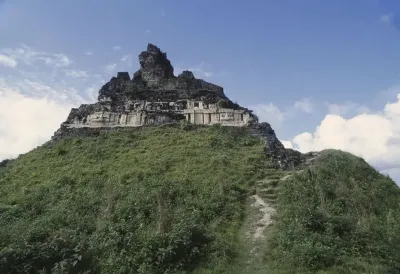 Xunantunich - Deep inside the jungle of Belize, Central America, archaeologists have uncovered what may be the largest royal tomb found in a century of work on Maya ruins in the country. Along with a range of mystifying hieroglyphs that hinted at the existence of a so-called "snake dynasty", researchers came across an altogether more gruesome object deep inside a forgotten tomb. On excavating a stairway to a large part of the structure, researchers found within it the remains of a male adult, believed to be aged between 20 and 30 years old, lying on his back with his head to the south. Archaeologist Professor Jamie Awe, who led the excavations with a team from his institute, Northern Arizona University, and the Belize Institute of Archaeology in 2016, said analysis revealed much about the man. Results showed he was athletic and "quite muscular" at the time of his death, though there was little indication to explain how he had died. Alongside the gruesome remains he and the team also found jaguar and deer bones, six jade beads potentially from a necklace, 13 obsidian blades, and 36 ceramic vessels. At the bottom of the staircase, they came across two caches that had nine obsidian and 28 chert flints and eccentrics, chipped artefacts that are shaped into animals, leaves, or other significant symbols. Even if none of this had been found, the tomb would have proved extraordinary given its vast size, some 4.5 metres by 2.4 metres. Most Maya tombs were built as additions to existing structures, but this tomb was built at the same time with the structure around it. A common practice with the ancient Egyptians, it has never been seen before among the Maya.“In other words, it appears that the temple was purposely erected for the primary purpose of enclosing the tomb," Prof Awe said. "Except for a very few rare cases, this is not very typical in ancient Maya architecture." Most Maya sites were ruled through family dynasties, and the tomb at Xunantunich is the first such royal tomb to be found at the site. Both male and female tombs have been found across Belize, including those of the so-called "snake dynasty", named after the snake-head emblem usually found alongside its structures. The snake dynasty dominated Belize for decades in the 7th century and moved their capital to various sites around the country. Prof Awe said the hieroglyphic panels found inside could prove "even more important than the tomb”, by providing clues to the dynasty’s history. His and the team's work was peer-reviewed for publication in the Journal of the Precolumbian Art Research Institute.
Xunantunich - Deep inside the jungle of Belize, Central America, archaeologists have uncovered what may be the largest royal tomb found in a century of work on Maya ruins in the country. Along with a range of mystifying hieroglyphs that hinted at the existence of a so-called "snake dynasty", researchers came across an altogether more gruesome object deep inside a forgotten tomb. On excavating a stairway to a large part of the structure, researchers found within it the remains of a male adult, believed to be aged between 20 and 30 years old, lying on his back with his head to the south. Archaeologist Professor Jamie Awe, who led the excavations with a team from his institute, Northern Arizona University, and the Belize Institute of Archaeology in 2016, said analysis revealed much about the man. Results showed he was athletic and "quite muscular" at the time of his death, though there was little indication to explain how he had died. Alongside the gruesome remains he and the team also found jaguar and deer bones, six jade beads potentially from a necklace, 13 obsidian blades, and 36 ceramic vessels. At the bottom of the staircase, they came across two caches that had nine obsidian and 28 chert flints and eccentrics, chipped artefacts that are shaped into animals, leaves, or other significant symbols. Even if none of this had been found, the tomb would have proved extraordinary given its vast size, some 4.5 metres by 2.4 metres. Most Maya tombs were built as additions to existing structures, but this tomb was built at the same time with the structure around it. A common practice with the ancient Egyptians, it has never been seen before among the Maya.“In other words, it appears that the temple was purposely erected for the primary purpose of enclosing the tomb," Prof Awe said. "Except for a very few rare cases, this is not very typical in ancient Maya architecture." Most Maya sites were ruled through family dynasties, and the tomb at Xunantunich is the first such royal tomb to be found at the site. Both male and female tombs have been found across Belize, including those of the so-called "snake dynasty", named after the snake-head emblem usually found alongside its structures. The snake dynasty dominated Belize for decades in the 7th century and moved their capital to various sites around the country. Prof Awe said the hieroglyphic panels found inside could prove "even more important than the tomb”, by providing clues to the dynasty’s history. His and the team's work was peer-reviewed for publication in the Journal of the Precolumbian Art Research Institute.
NORVEGE – 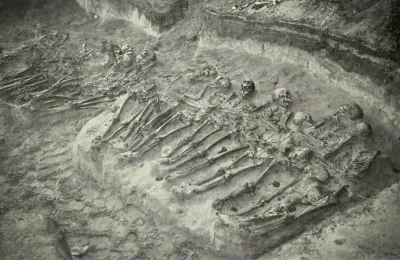 Træna - Katharina Lorvik is an archaeologist at the Norwegian Institute for Cultural Heritage Research (NIKU). Her specialty is osteoarchaeology, the analysis of skeletons. Lorvik will now start a research project where she will try to find out more about the special graves and human remains on Træna. The graves were discovered accidentally by archaeologist and ethnologist Gutorm Gjessing in 1937. Gjessing ensured that three mass graves and several smaller communal and individual graves on Træna were excavated between 1937 and 1939. He found a total of 33 dead inside the well-known Kirkhelleren on the island of Sanna, where the Trænafestival is held each year. He found two other mass graves near the water's edge on the same island. They contained a total of 24 dead. Today, 50 of these remains are stored at the University of Tromsø. A couple of the others were lost at sea during transport to Tromsø. “In our research project, we will go through all archaeological documentation that can give us information about when and how these graves were created,” Lorvik said at a recent NIKU seminar. “We will also conduct new analyses of sex and age. And we will look for traces of diseases and injuries on the skeletons.” Researchers will also perform a genetic mapping of all the dead. This could reveal a lot. According to Lorvik, it is likely that the mass graves are from the Middle Ages. “We believe they’re from around the time of the Black Death,” she says. An important part of the research project will therefore be to investigate whether it is possible to detect plague as the cause of death. “We also hope to be able to say more about how these people lived and where they came from,” she says.
Træna - Katharina Lorvik is an archaeologist at the Norwegian Institute for Cultural Heritage Research (NIKU). Her specialty is osteoarchaeology, the analysis of skeletons. Lorvik will now start a research project where she will try to find out more about the special graves and human remains on Træna. The graves were discovered accidentally by archaeologist and ethnologist Gutorm Gjessing in 1937. Gjessing ensured that three mass graves and several smaller communal and individual graves on Træna were excavated between 1937 and 1939. He found a total of 33 dead inside the well-known Kirkhelleren on the island of Sanna, where the Trænafestival is held each year. He found two other mass graves near the water's edge on the same island. They contained a total of 24 dead. Today, 50 of these remains are stored at the University of Tromsø. A couple of the others were lost at sea during transport to Tromsø. “In our research project, we will go through all archaeological documentation that can give us information about when and how these graves were created,” Lorvik said at a recent NIKU seminar. “We will also conduct new analyses of sex and age. And we will look for traces of diseases and injuries on the skeletons.” Researchers will also perform a genetic mapping of all the dead. This could reveal a lot. According to Lorvik, it is likely that the mass graves are from the Middle Ages. “We believe they’re from around the time of the Black Death,” she says. An important part of the research project will therefore be to investigate whether it is possible to detect plague as the cause of death. “We also hope to be able to say more about how these people lived and where they came from,” she says.
Unravelling the mystery of Træna mass graves: A medieval archaeological enigma (sciencenorway.no)
EGYPTE – 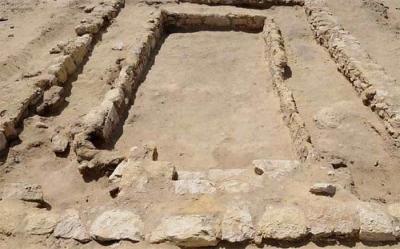 Watfa - In 2017, when the ruins of an ancient Greek gymnasium were discovered in an oasis of a desert in Egypt, archaeologists said that it was the first of its kind. The Watfa gymnasium that was used to train young Greek-speaking men in sports, literacy and philosophy was discovered by a joint Egyptian-German archeological team on the site of an ancient village southwest of Cairo in the Faiyum Oasis. The gymnasium included a large meeting hall, once adorned with statues, a dining hall and a courtyard in the main building. Surrounded by gardens, this center of Greek learning for young men in ancient Egypt also had a 200-meter (660-foot) running track, on which they trained for important 180-meter races. Watfa was founded 2,300 years ago in a small, rural village of 1,200 people – two-thirds Egyptians and one-third Greeks – by King Ptolemy II. The king named the village in Fayoum Oasis for his second sister Philotera. Philoteris was one of the new villages founded in the years after Alexander the Great invaded Egypt. Thousands of Greek-speaking settlers moved to the territory by the River Nile and built public buildings and baths which became meeting places for themselves and their Egyptian neighbors. The Hellenistic gymnasium was run by the village authorities and open to young men up to the age of 30. Women, slaves, freedmen, tradesmen, male prostitutes, drunkards and madmen were excluded.
Watfa - In 2017, when the ruins of an ancient Greek gymnasium were discovered in an oasis of a desert in Egypt, archaeologists said that it was the first of its kind. The Watfa gymnasium that was used to train young Greek-speaking men in sports, literacy and philosophy was discovered by a joint Egyptian-German archeological team on the site of an ancient village southwest of Cairo in the Faiyum Oasis. The gymnasium included a large meeting hall, once adorned with statues, a dining hall and a courtyard in the main building. Surrounded by gardens, this center of Greek learning for young men in ancient Egypt also had a 200-meter (660-foot) running track, on which they trained for important 180-meter races. Watfa was founded 2,300 years ago in a small, rural village of 1,200 people – two-thirds Egyptians and one-third Greeks – by King Ptolemy II. The king named the village in Fayoum Oasis for his second sister Philotera. Philoteris was one of the new villages founded in the years after Alexander the Great invaded Egypt. Thousands of Greek-speaking settlers moved to the territory by the River Nile and built public buildings and baths which became meeting places for themselves and their Egyptian neighbors. The Hellenistic gymnasium was run by the village authorities and open to young men up to the age of 30. Women, slaves, freedmen, tradesmen, male prostitutes, drunkards and madmen were excluded.
Ancient Gymnasium Unearthed in Oasis Shows Impact of Greek Life in Egypt - GreekReporter.com
PEROU –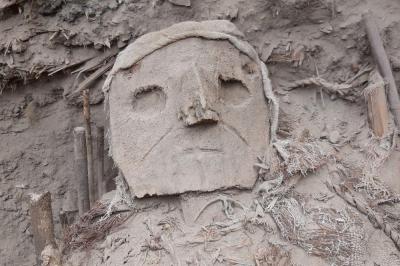
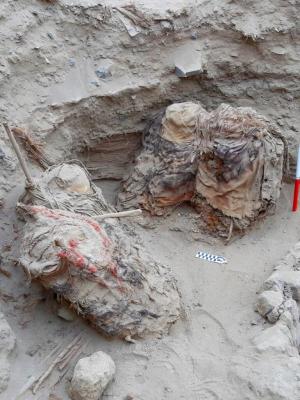
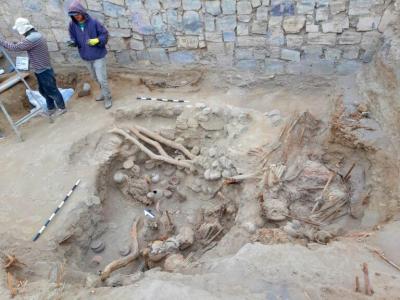 Pachacámac, - Dating from between 800 and 1100 AD, seventy-three intact “burial bundles” have been discovered by a Polish-led team at Pachacámac, an archaeological site south-east of Lima Belonging to the time of the Wari Empire, the discovery was made by a group of archaeologists employed by the Pontifical Catholic University of Peru. Led by Professor Krzysztof Makowski, the finds were made in a cemetery complex close to the so-called Painted Temple. Aware that much of the site had been robbed and desecrated, Makowski and his colleagues zoned in on a plot where an Incan period wall had collapsed as they had theorised that the piles of adobe bricks would have made the area difficult to rob. Their hypothesis proved correct. Notable for their near perfect state of preservation, it’s been revealed that some were initially buried individually, and others later in groups. Containing people of both genders, several were found wearing carved masks or adorned with ceramics placed on ‘false heads’. The importance of Makowski’s findings stand to shape our understanding relating to the cultural development of the pre-Hispanic Andes. So far, the discoveries seem to contradict commonly accepted facts. Presenting a different character during the period of the Wari Empire, the uncovered fardos appear to demonstrate that Pachacámac was not a sacred city for the whole time between the construction of the Old Temple and the arrival of the Spanish. In total, as many as nineteen of these bundles will now be transferred for laboratory tests that will include CT scans – these will allow for computer analysis to be made without opening them.
Pachacámac, - Dating from between 800 and 1100 AD, seventy-three intact “burial bundles” have been discovered by a Polish-led team at Pachacámac, an archaeological site south-east of Lima Belonging to the time of the Wari Empire, the discovery was made by a group of archaeologists employed by the Pontifical Catholic University of Peru. Led by Professor Krzysztof Makowski, the finds were made in a cemetery complex close to the so-called Painted Temple. Aware that much of the site had been robbed and desecrated, Makowski and his colleagues zoned in on a plot where an Incan period wall had collapsed as they had theorised that the piles of adobe bricks would have made the area difficult to rob. Their hypothesis proved correct. Notable for their near perfect state of preservation, it’s been revealed that some were initially buried individually, and others later in groups. Containing people of both genders, several were found wearing carved masks or adorned with ceramics placed on ‘false heads’. The importance of Makowski’s findings stand to shape our understanding relating to the cultural development of the pre-Hispanic Andes. So far, the discoveries seem to contradict commonly accepted facts. Presenting a different character during the period of the Wari Empire, the uncovered fardos appear to demonstrate that Pachacámac was not a sacred city for the whole time between the construction of the Old Temple and the arrival of the Spanish. In total, as many as nineteen of these bundles will now be transferred for laboratory tests that will include CT scans – these will allow for computer analysis to be made without opening them.
Polish archaeologists find over 70 ‘burial bundles’ in Peru – The First News
USA –  Rhode Island - An Australian museum is doubling down on its previously contested claim that a shipwreck off the coast of Rhode Island is the long-lost ship once sailed by British explorer and cartographer Captain James Cook. The Australian National Maritime Museum on Thursday said two new discoveries offer further evidence that a shipwreck located in Newport Harbor, Rhode Island, is the final resting place for the HMS Endeavour, a British Royal Navy vessel sailed by Cook during his first discovery voyage and the first European ship believed to have reached the eastern coast of Australia. The two recent findings held up as further evidence of the shipwreck's identity include the discovery of a pump well and part of the wreck's bow, the museum said. Museum researchers compared the new discoveries with archival plans of the Endeavour that were created during a British admiralty survey in 1768, After comparing the wreck to the historical documents, archeologists were able to accurately predict where the ship's bow would be located and found a unique joint in the timber matching information included in the original plans, according to the outlet. The Endeavour served to transport British troops during the Revolutionary War before being "scuttled" — or deliberately sunk — in 1778. Researchers believe the ship was one of five British vessels that now lie 39 meters below the Newport Harbour waters.
Rhode Island - An Australian museum is doubling down on its previously contested claim that a shipwreck off the coast of Rhode Island is the long-lost ship once sailed by British explorer and cartographer Captain James Cook. The Australian National Maritime Museum on Thursday said two new discoveries offer further evidence that a shipwreck located in Newport Harbor, Rhode Island, is the final resting place for the HMS Endeavour, a British Royal Navy vessel sailed by Cook during his first discovery voyage and the first European ship believed to have reached the eastern coast of Australia. The two recent findings held up as further evidence of the shipwreck's identity include the discovery of a pump well and part of the wreck's bow, the museum said. Museum researchers compared the new discoveries with archival plans of the Endeavour that were created during a British admiralty survey in 1768, After comparing the wreck to the historical documents, archeologists were able to accurately predict where the ship's bow would be located and found a unique joint in the timber matching information included in the original plans, according to the outlet. The Endeavour served to transport British troops during the Revolutionary War before being "scuttled" — or deliberately sunk — in 1778. Researchers believe the ship was one of five British vessels that now lie 39 meters below the Newport Harbour waters.
ALLEMAGNE – 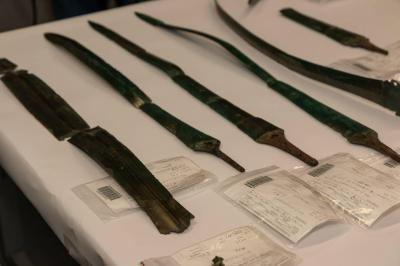 Mecklenburg - Volunteer archaeologists found bronze age seven swords and from the 11th century 6000 silver coins in the northeastern German state of Mecklenburg-Vorpommern. The seven swords were found in fragments near Mirow (Mecklenburg Lake District). Scientific dating has shown that the swords date back to the Bronze Age. Their age is estimated at around 3,000 years. The swords were likely left in the lowland area as a ritual or sacrificial offering, officials said. Although such deposits of valuable items are not unusual, so many Bronze Age swords have never been discovered in one place in Mecklenburg-Western Pomerania. According to the release, volunteers also discovered two other sets of finds, both from the 11th century, in different areas of Mecklenburg-Vorpommern. A collection of 6,000 silver coins was unearthed in Rügen, officials said. The find is the largest Slavic coin hoard of the post-war period to date.
Mecklenburg - Volunteer archaeologists found bronze age seven swords and from the 11th century 6000 silver coins in the northeastern German state of Mecklenburg-Vorpommern. The seven swords were found in fragments near Mirow (Mecklenburg Lake District). Scientific dating has shown that the swords date back to the Bronze Age. Their age is estimated at around 3,000 years. The swords were likely left in the lowland area as a ritual or sacrificial offering, officials said. Although such deposits of valuable items are not unusual, so many Bronze Age swords have never been discovered in one place in Mecklenburg-Western Pomerania. According to the release, volunteers also discovered two other sets of finds, both from the 11th century, in different areas of Mecklenburg-Vorpommern. A collection of 6,000 silver coins was unearthed in Rügen, officials said. The find is the largest Slavic coin hoard of the post-war period to date.
CHINE – Liangzhu - The research on Liangzhu ruins, located in eastern Zhejiang province, mainly delved into hypotheses regarding the city’s development phases and its pioneering water conservation system for its time, the official Xinhua agency reported. The findings offer a preliminary understanding of the three development phases of the Liangzhu city with a concept that the evolution began with scattered settlements, followed by the establishment of a sophisticated water conservancy system, culminating in the construction of the ancient city. The archaeological site, recognized as a UNESCO World Heritage site, stands as a crucial testament to the existence of Chinese civilization dating back at least 5,000 years. According to the heritage administration, recent archaeological discoveries and research findings have unveiled the evolution of settlement management and urban construction concepts, as well as insights into the belief system of the ancient Liangzhu inhabitants, a civilization thriving around the lakes of the Yangtze River delta five millennia ago.
Archaeologists find how China's ancient Liangzhu city was developed - La Prensa Latina Media
PAKISTAN –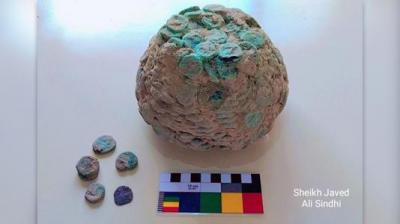 Mohenjo-Daro. - Archaeologists in Pakistan have unearthed an extremely rare hoard of copper coins, thought to be more than 2,000 years old, from the ruins of a Buddhist shrine built at the even more ancient site of Mohenjo-Daro. The coins and shrine — known as a stupa — are thought to date from the time of the Kushan Empire, a mainly Buddhist polity that ruled the region from about the second century B.C. until the third century A.D., and conquered the Greco-Bactrian kingdom established in Central Asia by Alexander the Great. "The stupa was built on the top of deserted ruins of Mohenjo-Daro after its decline [around] 1,600 years later," archaeologist and guide Sheikh Javed Ali Sindhi told Live Science. The newfound coins are colored green because copper corrodes when exposed to air. Centuries of corrosion have also fused the coins into a single lump that weighs about 12 pounds (5.5 kilograms). But a few coins have been found separately. The fused hoard probably consisted of between 1,000 and 1,500 individual coins, Sindhi said. Some of the outer coins of the fused hoard depict a standing figure, which the researchers think is probably a depiction of a Kushan king, he said. In about A.D. 150, the kings of the Kushan Empire are thought to have ordered the construction of the Buddhist stupa at Mohenjo-Daro. By that time the underlying ruins of the ancient city were almost 2,000 years old, but it's not known how much of the ancient site would have been visible at that time. The stupa was abandoned in about A.D. 500., possibly after being damaged in an earthquake or because Buddhism had declined in influence in that area.
Mohenjo-Daro. - Archaeologists in Pakistan have unearthed an extremely rare hoard of copper coins, thought to be more than 2,000 years old, from the ruins of a Buddhist shrine built at the even more ancient site of Mohenjo-Daro. The coins and shrine — known as a stupa — are thought to date from the time of the Kushan Empire, a mainly Buddhist polity that ruled the region from about the second century B.C. until the third century A.D., and conquered the Greco-Bactrian kingdom established in Central Asia by Alexander the Great. "The stupa was built on the top of deserted ruins of Mohenjo-Daro after its decline [around] 1,600 years later," archaeologist and guide Sheikh Javed Ali Sindhi told Live Science. The newfound coins are colored green because copper corrodes when exposed to air. Centuries of corrosion have also fused the coins into a single lump that weighs about 12 pounds (5.5 kilograms). But a few coins have been found separately. The fused hoard probably consisted of between 1,000 and 1,500 individual coins, Sindhi said. Some of the outer coins of the fused hoard depict a standing figure, which the researchers think is probably a depiction of a Kushan king, he said. In about A.D. 150, the kings of the Kushan Empire are thought to have ordered the construction of the Buddhist stupa at Mohenjo-Daro. By that time the underlying ruins of the ancient city were almost 2,000 years old, but it's not known how much of the ancient site would have been visible at that time. The stupa was abandoned in about A.D. 500., possibly after being damaged in an earthquake or because Buddhism had declined in influence in that area.
2,000-year-old coin stash discovered at ancient Buddhist shrine in Pakistan (msn.com)
CHINE - Pingtan - Chinese archaeologists have discovered Austronesian people settlements dating back 7,300 years on Pingtan Island in the southeastern Chinese province of Fujian. The findings reveal that the settlements were inhabited by people from a civilization that extended from southern China to Southeast Asia, the official China Daily reported Thursday. The focal point of this discovery is the Xiying archaeological site, estimated to be between 6,500 and 7,300 years old, according to China’s National Cultural Heritage Administration. Within this site, researchers found remnants of homes, human bones, stone artifacts, and pottery relics. Analysis of the unearthed human bones indicates a close genetic connection between the residents of these settlements and other groups of people in southern China and Southeast Asia. The findings support the theory that Austronesian peoples, now residing in Taiwan, Southeast Asia, Oceania, and other regions, originated in southern China. “It’s direct evidence for our studies to decode early groups of Austronesian peoples,” said Zhou Zhenyu, a researcher at the Archaeology Institute of the Chinese Academy of Social Sciences. Further evidence of Austronesian settlements on the island was discovered at the Keqiutou site dating back 5,000 to 6,500 years ago, and the Donghuaqiu and Guishan sites, which are 3,000 to 4,200 years old. These discoveries reveal that Austronesian peoples developed a sophisticated civilization on Pingtan Island, encompassing griculture, handicrafts, and the construction of complex structures, including residential areas and spaces for public activities.
FRANCE – 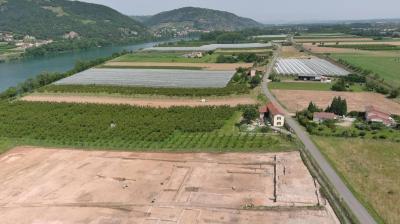
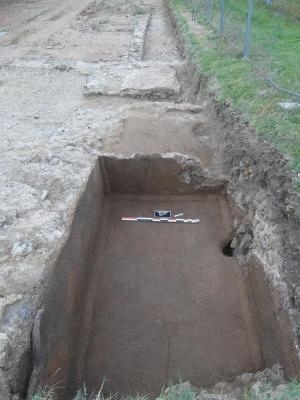
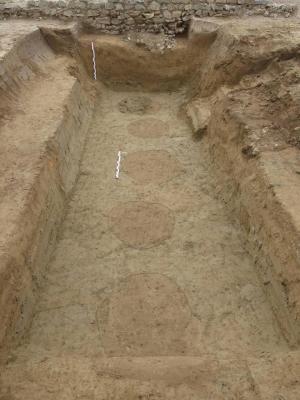 Laveyron - On the bank of a picturesque river in southern France sat a collection of ancient ruins. A buried cellar and empty pools are all that remain of a Roman-era winery. Archaeologists found the ruined winery in Laveyron during excavations for a factory’s parking lot, the French National Institute for Preventive Archaeological Research (Inrap) said in a Nov. 30 news release. The large-scale winemaking operation was built in the first century A.D. and probably produced drinks for ancient Romans, archaeologists said. The 1,900-year-old winery had a central platform where the grapes were pressed, the release said On either side of the platform, archaeologists found basins where the grape juice was collected. The basins were in turn linked to two larger rooms that archaeologists identified as cellars, the researchers said. A photo shows the cellar wall. A large section of the wall still stands. The construction appears to be made of neatly arranged, rectangular bricks. Excavations also uncovered a three-room building that was likely used for the wine production, archaeologists said. The imprints of several large jars, typically used for storing wine or olive oil, were also uncovered. A photo shows these darker-brown, medium-sized imprints.Archaeologists did not specify when or why the winery may have been abandoned. The excavation also found traces of several older buildings, dating to the first century B.C., the institute said. The function of these remains unknown, but a nearby trash heap from the same period revealed fragments of pottery, including the large jars used for wine and olive oil. Laveyron is along the Rhône river and about 300 miles southeast of Paris.
Laveyron - On the bank of a picturesque river in southern France sat a collection of ancient ruins. A buried cellar and empty pools are all that remain of a Roman-era winery. Archaeologists found the ruined winery in Laveyron during excavations for a factory’s parking lot, the French National Institute for Preventive Archaeological Research (Inrap) said in a Nov. 30 news release. The large-scale winemaking operation was built in the first century A.D. and probably produced drinks for ancient Romans, archaeologists said. The 1,900-year-old winery had a central platform where the grapes were pressed, the release said On either side of the platform, archaeologists found basins where the grape juice was collected. The basins were in turn linked to two larger rooms that archaeologists identified as cellars, the researchers said. A photo shows the cellar wall. A large section of the wall still stands. The construction appears to be made of neatly arranged, rectangular bricks. Excavations also uncovered a three-room building that was likely used for the wine production, archaeologists said. The imprints of several large jars, typically used for storing wine or olive oil, were also uncovered. A photo shows these darker-brown, medium-sized imprints.Archaeologists did not specify when or why the winery may have been abandoned. The excavation also found traces of several older buildings, dating to the first century B.C., the institute said. The function of these remains unknown, but a nearby trash heap from the same period revealed fragments of pottery, including the large jars used for wine and olive oil. Laveyron is along the Rhône river and about 300 miles southeast of Paris.
Ruins of ancient Roman-era winery found in France: photos | San Luis Obispo Tribune
